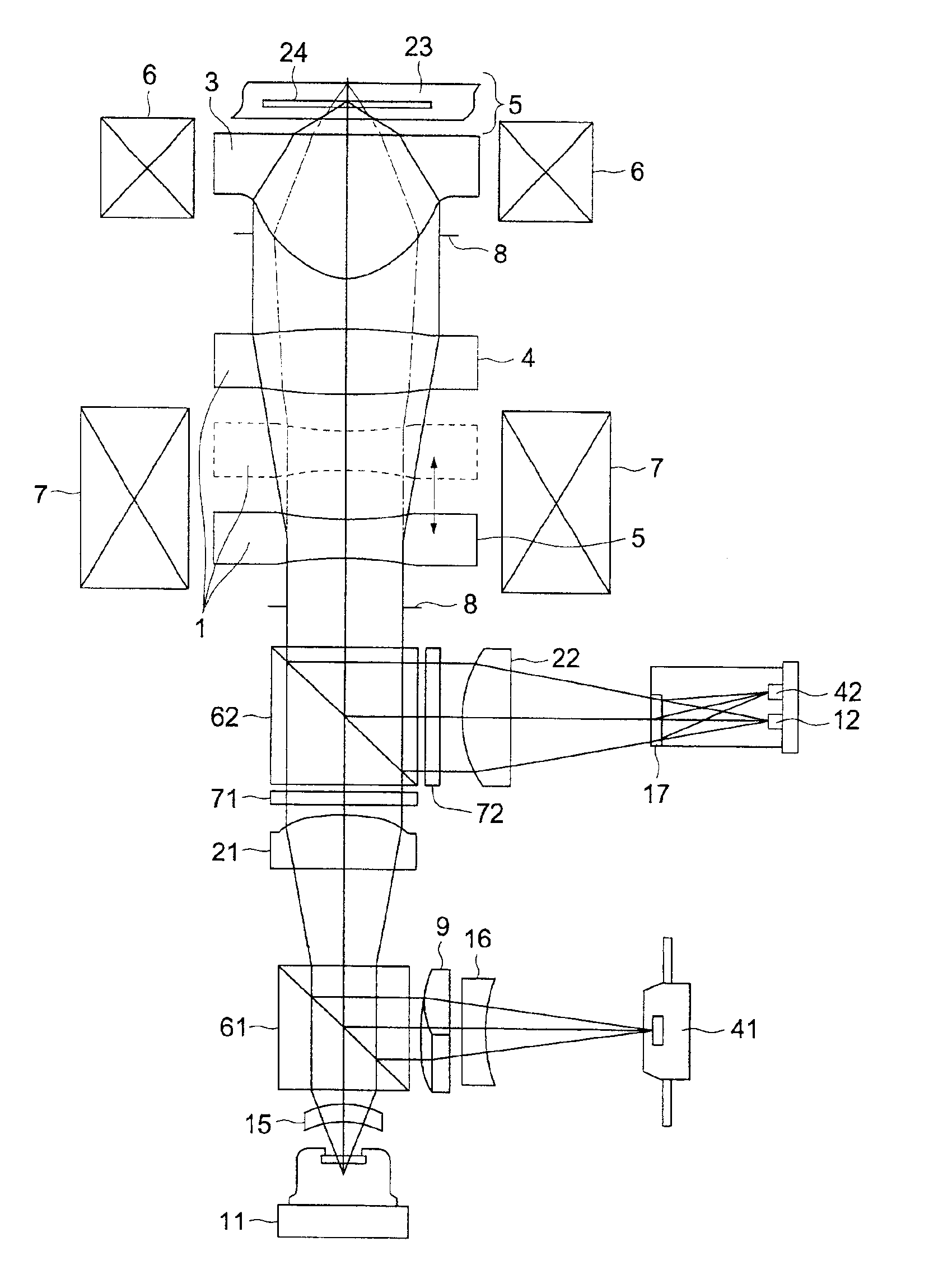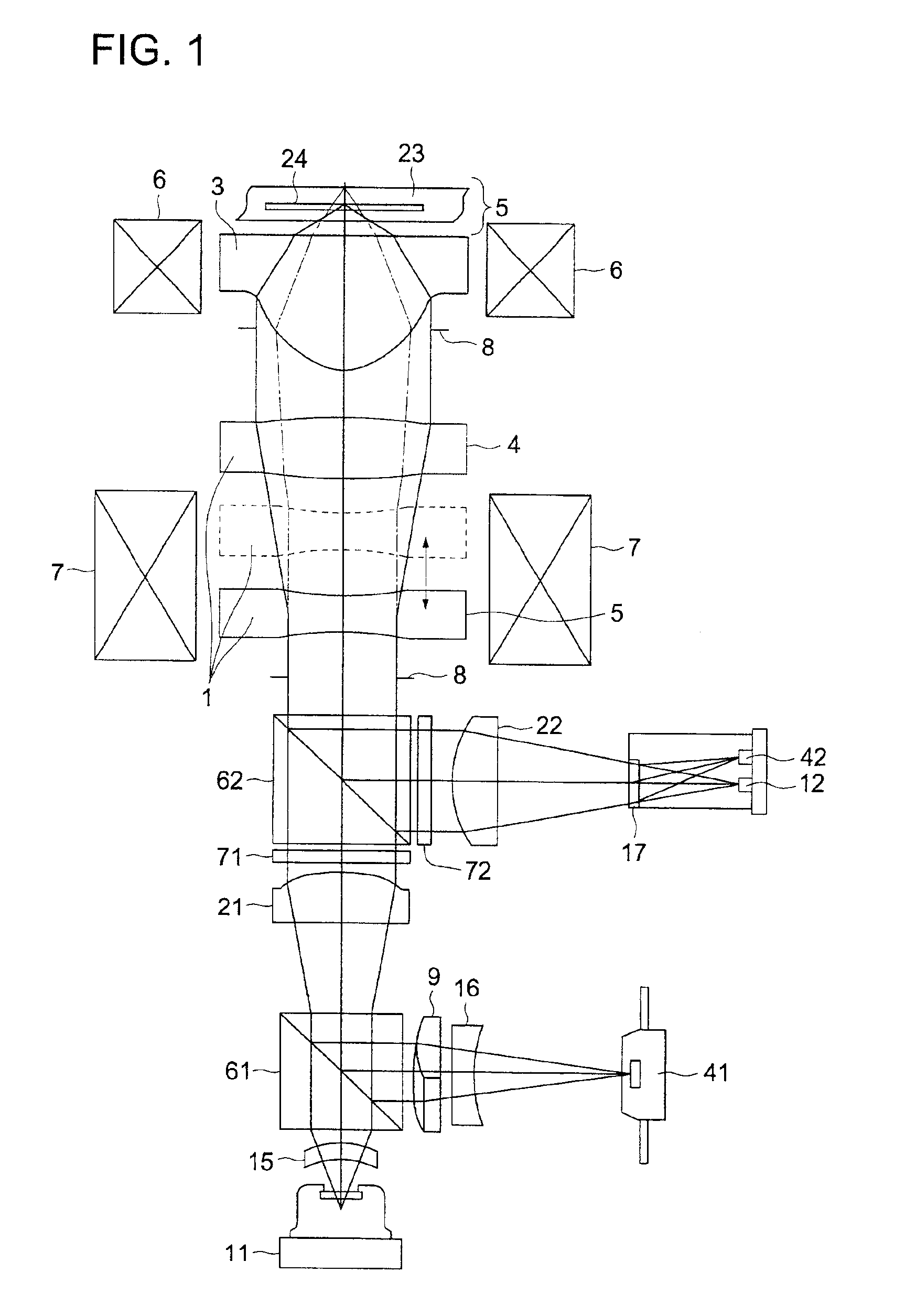Optical pick-up apparatus
a technology of optical pickup and optical lens, which is applied in the field of optical pickup apparatus, can solve the problems of deviation of spherical aberration taking place increase the spot diameter, and increase the coma of the spot, so as to lighten the burden of aberration correction by the diffractive structure provided on the objective lens, and reduce the generation of coma
- Summary
- Abstract
- Description
- Claims
- Application Information
AI Technical Summary
Benefits of technology
Problems solved by technology
Method used
Image
Examples
example 1
[0282]The data for the optical system composed of the negative lens 5, positive lens 4, and objective lens 3 in the example 1 is shown in Table 1. In this connection, in the data shown hereinafter, the powers of 10 (for example, 2.5×10−3) is expressed by using E (for example, 2.5×E−3). Further, the first order light by the diffraction of the diffractive surface expressed by the rotation symmetry polynomial means the light in which an angle of the ray of light changes in the converging direction after the diffraction.
[0283]
TABLE 1Example 1λ1 405 nm NA 0.85r (mm)d (mm)Nλ1νd1Spherical−604.7110.8001.9140923.82aberration7.5321.0003correction8.1221.2001.5071781.64means−11.1991.0005(Diaphragm)∞0.0006(AsphericObjective1.2332.6881.5252456.5surface 1,lensdiffractivesurface 1)7(Aspheric−0.9310.334surface 2)8Transparent∞0.1001.5194930.09substrate∞0.000Aspheric surface 1K −6.8440E − 01A4 1.7085E − 02A6 2.4417E − 03A8 1.4011E − 03A10 3.9966E − 04A12 −2.0375E − 04A14 1.8903E − 05A16 2.6231E − 05A...
example 2
[0287]The data relating to the optical system composed of the negative lens 5, positive lens 4 and objective lens 3 in the example 2 is shown in Table 3.
[0288]
TABLE 3Example 2λ1 405 nm NA 0.85r (mm)d (mm)Nλ1νd1Spherical−6.5510.8001.6194930.02aberration 5.5821.0003correction 8.5421.2001.5252456.54means−5.3641.0005(Diaphragm)∞0.0006(AsphericObjective 1.2332.6881.5252456.5surface 1,lensdiffractivesurface 1)7(Aspheric−0.9310.334surface 2)8Transparent∞0.1001.6194930.09substrate∞0.000Aspheric surface 1K −6.8440E − 01A4 1.7085E − 02A6 2.4417E − 03A8 1.4011E − 03A10 3.9966E − 04A12 −2.0375E − 04A14 1.8903E − 05A16 2.6231E − 05A18 2.3047E − 05A20 −1.4976E − 05Aspheric surface 2K−22.173426A4 0.345477A6 −0.821245A8 0.890651A10 −0.391613A12 −0.252257E − 03A14 −0.109061E − 09A16 −0.166822E − 10A18 −0.250470E − 11A20 −0.370377E − 12Diffractive surface 1B2 −7.0001E − 03
[0289]FIG. 4 is an optical system structural view of the negative lens 5, positive lens 4, and objective lens 3 according to the...
example 3
[0292]The data relating to the optical system composed of the negative lens 5, positive lens 4 and objective lens 3 in the example 3 is shown in Table 5.
[0293]
TABLE 5Example 3λ1 405 nm NA 0.85r (mm)d (mm)Nλ1νd1Spherical−20.486 0.8001.9140923.82aberration14.7291.0003correction26.2781.2001.5071781.64means−7.0401.0005(Diaphragm)∞0.0006(AsphericObjective 1.2252.8451.5252456.5surface 1)lens7(Aspheric−0.7630.292surface 2)8Transparent∞0.1001.6194930.09substrate∞0.000Aspheric surface 1K −0.699712A4 0.166009E − 01A6 0.209051E − 02A8 0.157932E − 02A10 0.212509E − 03A12 −0.344184E − 03A14 0.119417E − 04A16 0.577745E − 04A18 0.409189E − 04A20 −0.257292E − 04Aspheric surface 2K−20.033672A4 0.331327A6 −0.881378A8 0.965015A10 −0.412771A12 −0.252257E − 03A14 −0.110756E − 09A16 −0.168921E − 10A18 −0.253030E − 11A20 −0.370376E − 12
[0294]FIG. 6 is an optical system structural view of the negative lens 5, positive lens 4, and objective lens 3 according to the example 3. FIG. 7 is a spherical aberratio...
PUM
| Property | Measurement | Unit |
|---|---|---|
| wavelength | aaaaa | aaaaa |
| wavelength | aaaaa | aaaaa |
| thickness | aaaaa | aaaaa |
Abstract
Description
Claims
Application Information
 Login to View More
Login to View More - R&D
- Intellectual Property
- Life Sciences
- Materials
- Tech Scout
- Unparalleled Data Quality
- Higher Quality Content
- 60% Fewer Hallucinations
Browse by: Latest US Patents, China's latest patents, Technical Efficacy Thesaurus, Application Domain, Technology Topic, Popular Technical Reports.
© 2025 PatSnap. All rights reserved.Legal|Privacy policy|Modern Slavery Act Transparency Statement|Sitemap|About US| Contact US: help@patsnap.com



